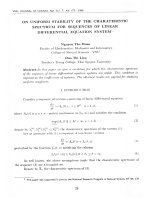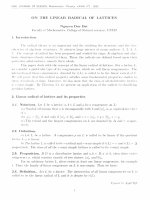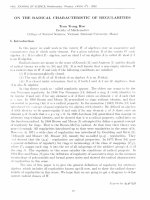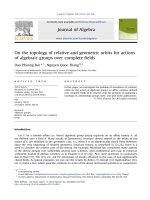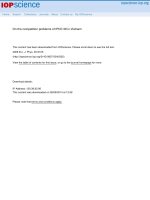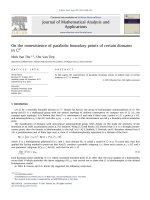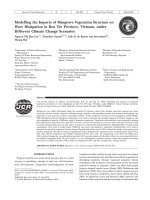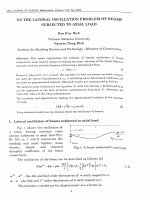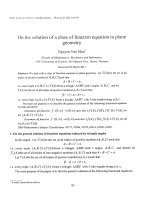DSpace at VNU: On the conduct of monetary policy in Vietnam
Bạn đang xem bản rút gọn của tài liệu. Xem và tải ngay bản đầy đủ của tài liệu tại đây (490.22 KB, 12 trang )
bs_bs_banner
doi: 10.1111/j.1467-8411.2012.01335.x
On the conduct of monetary policy in Vietnam
apel_1335
34..45
Thi Thu Tra Pham and James Riedel*
Vietnam has the highest inflation rate in Southeast Asia (over 20 per cent
year-on-year in 2011). This paper examines the extent to which inflation in
Vietnam is due to its conduct of monetary policy. It is argued that, had the
central bank implemented policy on a more timely basis, inflation would not
have been as high as it was, but the more fundamental problem is that the
central bank does not have the tools it needs to conduct monetary policy
effectively. Monetary policy is further complicated by Vietnam’s exchange
rate policy. By choosing to peg the currency and maintain fairly free capital
mobility, the country has all but given up the ability to pursue an independent monetary policy. As a consequence, the central bank is forced to attempt
to sterilise its foreign exchange interventions, which it is ill-equipped to do.
The paper argues that financial sector liberalisation is needed not only to
promote growth but also to maintain macroeconomic stability.
‘Yes’, had the SBV implemented policy on a
more timely basis, the inflation rate would
probably not be as high as it is. But, ‘no’, the
fundamental problems plaguing the conduct of
monetary policy in Vietnam are not of the
SBV’s making. The SBV does not have the tools
it needs to conduct monetary policy effectively,
in large part because the government has not
given priority to financial sector liberalisation,
and in particular to the development of a liquid
secondary bond market.
In addition, the SBV faces another challenge
in conducting monetary policy that is not
always given due consideration, which is Vietnam’s exchange rate policy. By choosing to peg
the dong to the dollar—albeit with adjustments that have increased in magnitude and
frequency in recent years—and maintain fairly
Macroeconomic stabilisation is at the top of the
policy agenda in Vietnam.1 The inflation rate
rose to 22 per cent in May 2011 (year-on-year).
The value of the dong in May 2011 was down
19 per cent from a year ago, as indeed it would
have to be for Vietnam to maintain its international price competitiveness. Bank lending
rates in May 2011 were reportedly above
20 per cent, again as they would have to be for
lenders to be willing to make a loan if the
expected inflation rate were anywhere near the
current rate. The problem is inflation. Since it is
widely understood that ‘inflation is always and
everywhere a monetary phenomenon’, questions have been raised about the State Bank of
Vietnam’s (SBV) conduct of monetary policy.
Does the SBV deserve criticism? The answer
offered here is an unequivocal ‘yes’ and ‘no’.
*
1
Thi Thu Tra Pham, Lecturer in Economics, International University and Vietnam National University, and James Riedel,
Professor of International Economics, Johns Hopkins University School of Advanced International Studies, Washington
DC. The paper was written under the auspices of the USAID/STAR-Vietnam project. The paper reflects the views and
opinions of the authors and not necessarily those of USAID/STAR or any government agency. The authors are grateful
to Ben Bingham, Vuong Quan Hoang, Phan Quang, Jonathan Pincus, and Scott Robertson for comments and suggestions,
but alone are responsible for any errors or omissions.
Resolution 11, February 24, 2011, made it official.
34
© 2012 Crawford School of Public Policy,
The Australian National University and Blackwell Publishing Asia Pty Ltd.
PHAM AND RIEDEL — ON THE CONDUCT OF MONETARY POLICY
Table 1
A stylised version of the financial system
Central bank
Assets
Commercial banks
Liabilities
Foreign
reserves (R)
Domestic
securities (D)
Currency in
circulation
(CC)
Bank reserves
(BR)
Assets
Households/businesses
Liabilities
Loans
Deposits
(DEP)
Bank reserves
(BR)
Net claims on
commercial
banks (NC)
Net claims on
commercial
banks (NC)
Assets
Currency in
circulation
(CC)
Deposits
(DEP)
Liabilities
Loans
Other
liabilities
Other assets
free capital mobility—de facto, if not de jure—
Vietnam has all but given up the ability to
pursue an independent monetary policy. The
only opening for an independent monetary
policy that is available to the SBV is through the
sterilisation of foreign exchange market interventions. Indeed, attempts to sterilise massive
intervention in the foreign exchange market
have been the main driver of monetary policy
in recent years.
The scope of this paper is confined to the
SBV’s conduct of monetary policy, by which
we mean how and to what effect it has used the
instruments of monetary policy at its disposal.
We do not address the issue of how credit was
allocated, which, given its rapid growth under
conditions of high and volatile interest rates,
has justifiably raised concerns about a deterioration in the quality of bank loans and a
growing vulnerability of the banking system to
a crisis.
by households and businesses. Currency in circulation is a liability of the central bank, and
bank deposits are liabilities of the commercial
banks. Commercial banks, in turn, deposit
with the central bank a fraction of the deposits
they take from households and businesses as
bank reserves (BR). The liabilities of the central
bank constitute base (or reserve) money (B =
CC + BR). Since the liabilities of the central
bank are matched by its assets, base money can
also be defined as the sum of central bank
assets (B = R + D + NC) (Table 1).
The central bank conducts monetary policy
by adjusting the size of its balance sheet (B)
and by adjusting the money multiplier (mm),
defined as the ratio of the money supply to
base money:
mm =
M
CC + DEP
1+ c
=
=
.
B CC + RR + ER c + r + e
As shown in the above equation, the size of
the money multiplier depends on the ratios of
currency to deposits (c), required reserves to
deposits (r), and excess reserves to deposits
(e). In the reserve requirement ratio (r), the
central bank has an instrument for managing
the money supply by changing the money
multiplier.
In addition, the central bank manages the
size of its balance sheet (that is, base money)
through open-market operations—buying and
selling domestic-currency securities, mainly
Analytical framework
A stylised version of the balance sheets of the
financial and non-financial sectors of the
economy (presented in Table 1) serves as a
framework for analysing the conduct of monetary policy in Vietnam. The money supply
(M), broadly defined, consists of currency in
circulation (CC) and bank deposits (DEP) held
35
© 2012 Crawford School of Public Policy,
The Australian National University and Blackwell Publishing Asia Pty Ltd.
ASIAN-PACIFIC ECONOMIC LITERATURE
(or closely manage) its exchange rate, it has ipso
facto chosen a monetary policy. Under a fixed
exchange rate regime, the central bank is
obliged to intervene in the foreign exchange
market, buying foreign reserves (R↑) whenever there is an excess supply, and selling
foreign reserves (R↓) whenever there is an
excess demand in the foreign exchange market.
When the central bank intervenes, buying and
selling foreign exchange reserves, base money
goes up and down, and with it (via the money
multiplier) the money supply. That is why, as a
general rule, a country that fixes its exchange
rate cannot have an independent monetary
policy. The money supply is, in effect, determined by conditions in the foreign exchange
market, in other words by international trade
and foreign capital flows.
There are, however, exceptions to the
general rule. One exception is if a country that
fixes its exchange rate tightly controls supply
and demand in the foreign exchange market,
for example by strictly controlling foreign
capital inflows and outflows. The other exception is if a country sterilises the monetary effect
of its intervention in the foreign exchange
market by matching the purchase (sale) of
foreign reserves with the sale (purchase) of
domestic securities. Through sterilisation, the
central bank can, in principle, increase or
reduce its foreign reserves without any effect
on the size of its balance sheet (that is, without
any effect on base money, and hence on the
money supply).
government bonds—and by borrowing from
and lending to commercial banks through its
lending facilities (for example, the discount
and repo windows). When the central bank
buys (sells) government debt or lends to
(borrows from) banks, its assets (D or NC) and
liabilities (BR) go up (down), and with it the
money supply.
In countries with developed financial
markets, central banks typically rely mainly on
open market operations—that is, buying and
selling government bonds in the secondary
bond market. Little use is made of the reserve
requirement ratio or lending to commercial
banks. The reserve requirement ratio is a
clumsy and often ineffective tool of monetary
policy, especially when commercial banks hold
excess reserves, and hence are not constrained
by the reserve requirement ratio. Lending to
commercial banks via the discount or repo
windows is also not an effective way to manage
base money. Generally, central banks set the
discount interest rate 100–200 basis points
above the inter-bank interest rate to discourage
commercial banks from borrowing reserves
except in exceptional circumstances.
The opposite is the case in Vietnam. The
absence of a liquid secondary government
bond market limits the use of conventional
open-market operations in Vietnam. Instead,
the SBV relies mainly on its lending facilities
(refinance and repo windows) to manage base
money, and uses the reserve requirement ratio
to adjust the money multiplier. As a result, it is
difficult for the SBV to ‘fine-tune’ monetary
policy or take timely actions. In addition, the
SBV routinely resorts to non-market administrative measures, such as caps on interest rates,
limitations on the growth rate of bank credit,
and restrictions on lending to different sectors
of the economy—all of which create wellknown distortions and inefficiencies in the
credit market.
Foreign exchange market intervention
Vietnam pegs its currency to the dollar, but
with sporadic adjustments. In spite of these
adjustments, which, as noted, have increased
in magnitude and frequency in recent years,
the SBV has been obliged to intervene heavily
in the foreign exchange market to keep the
nominal exchange rate within the band that it
sets around the official rate. The annual level of
central bank intervention is indicated by the
change in foreign reserves in the balance of
payments, illustrated in Figure 1.
Exchange rate policy as
monetary policy
The conduct of monetary policy depends on
exchange rate policy. If a country chooses to fix
36
© 2012 Crawford School of Public Policy,
The Australian National University and Blackwell Publishing Asia Pty Ltd.
PHAM AND RIEDEL — ON THE CONDUCT OF MONETARY POLICY
Figure 1
Major balances of the balance of payments: quarterly (US$ millions)
10000
8000
6000
Change in Foreign Reserves
Capital Account Balance
plus Errors and Ommisions
4000
2000
0
Q1 2006Q3 2006Q1 2007Q3 2007Q1 2008Q3 2008 Q1 2009 Q3 2009 Q1 2010 Q3 2010
-2000
-4000
-6000
Current Account Balance
-8000
Source: IMF, International Financial Statistics, online.
2010 was via the black market, it showed up in
the balance of payments as negative net errors
and omissions, that is, unrecorded capital
outflow. As a result of the foreign capital flight
in 2008 and domestic capital flight in 2009 and
2010, all of the foreign exchange reserves accumulated in 2007 and Q1 2008 were sold back to
the market (together with an additional US$1
billion) by the end of 2010, leaving the level of
reserves at a precariously low level at the
beginning of 2011 (Figure 2).
As Figure 1 indicates, 2007, the year
Vietnam acceded to the WTO, was a watershed.
Foreign direct and indirect investment in
Vietnam soared to a level equivalent to
25 per cent of GDP. After financing a current
account deficit of about 10 per cent of GDP, the
SBV was obliged to buy foreign reserves
equivalent to 15 per cent of GDP.
The excess supply of foreign exchange
ended in the second quarter of 2008, when
foreign (indirect) investors, spooked by rising
inflation and growing trade deficits, made a
run on the currency, forcing the SBV (in Q2
2008) to sell back to the market about one third
of the US$13 billion in foreign reserves it had
purchased from Q1 2007 through Q1 2008.
An excess demand for foreign exchange
re-emerged in Q1 2009 and continued through
Q3 2010 (the most recent quarter for which
International Financial Statistics balance of payments data are available), as domestic residents
attempted to convert dong assets into dollars
and gold in anticipation of devaluation. Since
much of the domestic capital flight in 2009 and
Sterilisation of market intervention
As Figures 3 and 4 indicate, foreign reserves
were the principal component of base money
until the SBV was obliged to sell off a large
portion of its foreign reserves in 2009 and 2010.
In 2007 and Q1 2008, when foreign capital
flooded the foreign exchange market, requiring
large interventions to prevent nominal appreciation, the SBV undertook to sterilise its
reserves purchases, mainly by selling dong37
© 2012 Crawford School of Public Policy,
The Australian National University and Blackwell Publishing Asia Pty Ltd.
ASIAN-PACIFIC ECONOMIC LITERATURE
Figure 2
The capital account plus errors and omissions: quarterly (US$ millions)
10000
8000
6000
4000
2000
0
Q1
-2000 2006
Q3
2006
Q1
2007
Q3
2007
Q1
2008
Q3
2008
Q1
2009
Q3
2009
Q1
2010
Q3
2010
-4000
-6000
Net FDI
Portfolio Flows
Other Net Flows
E&O
E&O = error and omissions, FDI = foreign direct investment.
Source: IMF, International Financial Statistics, online.
exchange to the commercial banks, thereby
allowing for an expansion of base money.
denominated ‘sterilisation bonds’ (claims on
the SBV) to commercial banks. However, the
level of sterilisation did not match the level of
intervention; hence, base money and M2 grew
rapidly, leading to an acceleration of inflation
(discussed below).
With the reversal of capital flows from mid2008 onwards, the SBV was again obliged to
intervene heavily in the foreign exchange
market, selling foreign exchange from its
reserves to meet the commercial banks’ excess
demand. To offset the massive reduction in
base money that would otherwise have
occurred from its sale of foreign exchange to
banks, the SBV sterilised its intervention by
buying domestic securities and, more significantly, by lending bank reserves to commercial
banks through the SBV’s refinance and repo
lending facilities. As Figures 3 and 4 indicate,
the volume of SBV lending to commercial
banks exceeded the amount required to sterilise the monetary effect of selling foreign
Instruments of monetary policy
in Vietnam
Figures 5 and 6 provide an overview of how
the SBV has used the reserve requirement ratio
and its lending facilities to manage base money
and the money multiplier.
From 2006 to early 2009, the growth rate of
M2 closely paralleled the growth rate of base
money, albeit with more volatility in the
growth rate of base money because of seasonal
variation in the demand for cash (which, as
shown below, is associated with the lunar new
year). The close relationship between the
average growth rates of base money and M2
until early 2009 implies that, over that period,
the money multiplier was fairly constant, as
indeed Figure 6 shows it was. However, in
38
© 2012 Crawford School of Public Policy,
The Australian National University and Blackwell Publishing Asia Pty Ltd.
PHAM AND RIEDEL — ON THE CONDUCT OF MONETARY POLICY
Figure 3
Level of base money and its components (VND billions)
600000
500000
400000
300000
200000
100000
0
M1 M7 M1 M7 M1 M7 M1 M7 M1 M7 M1 M7 M1
-1000002005 2005 2006 2006 2007 2007 2008 2008 2009 2009 2010 2010
-200000
Net Domestic Assets
Net Foreign Assets
Base Money
Source: IMF, International Financial Statistics, online.
when commercial banks hold excess reserves is
clearly revealed in the statistics for the year
2007. In 2007, the SBV was obliged to buy up
commercial banks’ excess supply of foreign
exchange, consequent on massive inflows of
foreign capital. In an attempt to sterilise the
monetary impact of its foreign exchange purchases, the SBV, in mid-2007, more than
doubled the reserve requirement ratio, but, as
indicated in Figure 4, this move did not have
the expected effect of lowering the money multiplier. The reason it did not, as Figure 6 indicates, is because commercial banks, at that
time, were holding a large stock of excess
reserves at the SBV, and hence were not constrained by the reserve requirement ratio. As a
result, the rise in the reserve requirement ratio
did not force banks to rein in credit growth.
Recall that in 2009, the government implemented a stimulus policy to counter the deflationary effects of the global recession. At the
same time, capital flight required the government to sell off a substantial amount of foreign
early 2009, the money multiplier began to rise
dramatically, creating an almost 20 percentage
point disparity between the growth rates of
base money and M2.
Reserve requirement ratio
The money multiplier rises when the ratio of
currency in circulation to deposits declines
(c↓), the reserve requirement ratio declines
(r↓), or excess reserves decline (e↓). As
Figure 7 indicates, the currency–deposit ratio
has been declining, steadily over the entire
period, not abruptly in 2009 when the money
multiplier began to rise. Figure 7 also indicates
that seasonal factors, in particular the lunar
New Year holiday, explain the volatility in base
money. The main explanation for the rise in the
money multiplier in 2009 and 2010 was a
reduction in the reserve requirement ratio and
excess reserves, as illustrated in Figure 8.
The ineffectiveness of the reserve requirement ratio as an instrument of monetary policy
39
© 2012 Crawford School of Public Policy,
The Australian National University and Blackwell Publishing Asia Pty Ltd.
ASIAN-PACIFIC ECONOMIC LITERATURE
Figure 4
Change (YOY) in base money and its components (VND billions)
200000
150000
100000
50000
0
M1 2006
M1 2007
M1 2008
M1 2009
M1 2010
M1 2011
-50000
-100000
-150000
Change in NFA
Change in Net Claims on Govt Change in Net Claims on Banks
NFA = net foreign assets.
Source: IMF, International Financial Statistics, online.
Figure 5
Rate of growth of base money and M2: January 2006 through October 2010 (%)
70
60
50
40
30
20
10
0
M1
-102006
M7
2006
M1
2007
M7
2007
M1
2008
M7
2008
M1
2009
M7
2009
M1
2010
M7
2010
M1
2011
-20
M2 Growth Rate
Base Money Growth Rate
Source: IMF, International Financial Statistics, online.
40
© 2012 Crawford School of Public Policy,
The Australian National University and Blackwell Publishing Asia Pty Ltd.
PHAM AND RIEDEL — ON THE CONDUCT OF MONETARY POLICY
Figure 6
The money multiplier: January 2005 through October 2010
6.0
5.5
5.0
4.5
4.0
3.5
3.0
M1
M7
M1
M7
M1
M7
M1
M7
M1
M7
M1
M7
M1
2005 2005 2006 2006 2007 2007 2008 2008 2009 2009 2010 2010 2011
Source: IMF, International Financial Statistics, online.
Figure 7
Currency/deposit ratio: January 2005 to October 2010
0.35
Ratio of Currency in Circulation to Total Deposits
0.30
0.25
0.20
0.15
0.10
M1
M7
M1
M7
M1
M7
M1
M7
M1
M7
M1
M7
M1
2005 2005 2006 2006 2007 2007 2008 2008 2009 2009 2010 2010 2011
Sources: IMF, International Financial Statistics, online; State Bank of Vietnam, online.
reserves to prevent an even larger devaluation
of the dong than occurred. To sterilise the monetary effect of selling off foreign reserves and to
stimulate the economy by easing credit condi-
tions, the SBV lowered the reserve requirement
ratio from about 12 per cent to only 2 per cent.
The reserve requirement ratio was not revised
upward until early 2011, even though by early
41
© 2012 Crawford School of Public Policy,
The Australian National University and Blackwell Publishing Asia Pty Ltd.
ASIAN-PACIFIC ECONOMIC LITERATURE
Figure 8
Ratio of reserves to dong and total deposits and the reserve requirement ratio
0.25
0.20
Ratio of Reserves
to Dong Deposits
0.15
Ratio of Reserves
to Total Deposits
0.10
0.05
Reserve Requirement Ratio
0.00
M1
2006
M7
2006
M1
2007
M7
2007
M1
2008
M7
2008
M1
2009
M7
2009
M1
2010
M7
2010
M1
2011
Sources: IMF, International Financial Statistics, online; State Bank of Vietnam, online.
compulsory sterilisation bonds) and lending to
commercial banks (through the refinance and
reverse repo facilities) is shown in Figure 9.
The commercial banks were compelled to hold
sterilisation bonds in 2007 and 2008, but they
were not compelled to borrow from the SBV to
sterilise the sale of foreign exchange to the
commercial banks in 2009 and 2010. Instead,
the commercial banks were offered the opportunity to borrow reserves at interest rates well
below market rates (even below the inter-bank
rate), creating profitable interest arbitrage
opportunities. Consequently, commercial
banks borrowed heavily from the SBV, at least
until April 2011, when spiralling inflation
eventually led the SBV to raise its lending rates
from 7 per cent to 15 per cent, significantly
reducing (if not eliminating) the profitability of
borrowing reserves. As a result of the banks’
massive borrowing from the SBV, net reserves
(commercial banks’ deposits at the SBV minus
net borrowing from the state bank) fell precipitously to negative levels by the end of 2010,
eliminating entirely the liquidity cushion that
bank reserves provide (Figure 10).
2010, it was acknowledged that the economy
was overheating and monetary tightening was
called for. Lowering the reserve requirement
ratio in 2009 worked to raise the money multiplier as the SBV intended it to do, but when
macroeconomic conditions changed in 2010,
the SBV failed to respond by raising r.
Net claims on commercial banks
The SBV has also used its refinance and reverse
repo lending facilities to sterilise foreign
exchange market intervention and manage
base money. In 2007 and early 2008, the SBV
issued compulsory sterilisation bonds to commercial banks to absorb, at least partially,
excess banks reserves created by SBV foreign
exchange purchases from commercial banks.
When the foreign capital flow reversed direction, in particular in 2009 and 2010, the SBV
used its lending facilities to replace declining
bank reserves consequent on its foreign
exchange sales to commercial banks.
The magnitude of SBV borrowing from
commercial banks (through the issuance of
42
© 2012 Crawford School of Public Policy,
The Australian National University and Blackwell Publishing Asia Pty Ltd.
PHAM AND RIEDEL — ON THE CONDUCT OF MONETARY POLICY
Figure 9
SBV borrowing from and lending to commercial banks (VND bill)
250000
200000
150000
SBV Loans to Commercial Banks
via Discount & Repo Windows
100000
50000
0
M1 2005
M1 2006
M1 2007
M1 2008
M1 2009
M1 2010
M1 2011
-50000
SBV Sterilization Bonds
Issued to Banks
-100000
SBV = State Bank of Vietnam.
Source: IMF, International Financial Statistics, online.
The growth of base money, M2,
and inflation
Conclusion
The SBV’s attempts to sterilise its heavy intervention in the foreign exchange market are
what have largely formed its conduct of monetary policy in recent years. Since sterilisation
is a means of finessing rather than correcting
the market disequilibria that required intervention in the first place, the SBV has been
forced to adjust the rate at which it pegs the
dong to the dollar repeatedly and in ever larger
amounts. Moreover, the sterilisation tools at its
disposal have not been up to the task, as two
waves of double-digit inflation in the past five
years attest.
One solution might be to float the currency,
but that would simply shift the problem, not
solve it. Surges in capital inflows and outflows
that are of a magnitude of those of recent years
would have caused major swings in the
As Figure 11 indicates, Vietnam experienced
two surges in money and credit growth over
the past five years. The first, in 2007 and 2008,
was driven by the monetisation of massive
capital inflows that were only partially sterilised. The second, in 2009 and 2010, resulted
from the rise in the money multiplier consequent on reductions in the reserve requirement
ratio, and by growth in central bank credit to
commercial banks that more than offset the
decline in base money consequent on declining
foreign reserves. As Figure 12 suggests, the
surge in money and credit growth in 2007–08
and again in 2009 and 2010 was accompanied
by a rise in the inflation rate, validating the
well-known proposition that inflation is always
and everywhere a monetary phenomenon.
43
© 2012 Crawford School of Public Policy,
The Australian National University and Blackwell Publishing Asia Pty Ltd.
ASIAN-PACIFIC ECONOMIC LITERATURE
Figure 10
Net bank reserves as a % of deposits
0.20
0.15
Ratio of Reserves
to Deposits
0.10
0.05
Ratio of Net Reserves
to Deposits
0.00
M1 M7 M1 M7 M1 M7 M1 M7 M1 M7 M1 M7 M1
2005 2005 2006 2006 2007 2007 2008 2008 2009 2009 2010 2010 2011
-0.05
-0.10
Source: IMF, International Financial Statistics, online.
Figure 11
Monthly (YOY) money and credit growth rates (percentages)
60
Credit Growth Rate
55
50
45
40
35
30
25
20
M2 Growth Rate
15
10
M1
2006
M7
2006
M1
2007
M7
2007
M1
2008
M7
2008
M1
2009
M7
2009
M1
2010
M7
2010
M1
2011
Source: IMF, International Financial Statistics, online.
44
© 2012 Crawford School of Public Policy,
The Australian National University and Blackwell Publishing Asia Pty Ltd.
PHAM AND RIEDEL — ON THE CONDUCT OF MONETARY POLICY
Figure 12
Monthly (YOY) money and credit growth rates (lagged) and the CPI inflation rate
70
Rate of Growth of Credit
(lagged 6 months)
60
50
40
30
Rate of Growth
of M2 (lagged 9 months)
20
10
CPI Inflation Rate
0
M9 M1 M5 M9 M1 M5 M9 M1 M5 M9 M1 M5 M9 M1 M5
2006 2007 2007 2007 2008 2008 2008 2009 2009 2009 2010 2010 2010 2011 2011
Source: IMF, International Financial Statistics, online.
monetary policy, and they would facilitate
the financing of the government deficits and
provide an important instrument for financing
long-term investment. Financial liberalisation
would also help the SBV to wean itself from its
overreliance on administrative measures, such
as caps on interest rates, targets on credit
growth, and quotas on lending by sector,
which distort credit markets and lead to misallocation of Vietnam’s scarcest resource—
capital.
Macroeconomic policy is difficult as it can
only be understood in a general equilibrium
framework. The goods market, money market,
and foreign exchange market are inextricably
linked by a unique configuration of relative
prices—the interest rate, exchange rate, and
inflation rate. That being the case, the authorities can attempt to anchor the macroeconomy
by fixing (or targeting) one of those relative
prices, but it cannot simultaneously target all of
them. Attempting to do so by administrative
directives, as the SBV won’t do, all but guarantees that macro disequilibrium in one manifestation or another will be a permanent feature of
the economy.
nominal and real exchange rate, with deleterious consequences for resource allocation and
growth every bit as severe as those associated
with monetary instability. Given the importance of export-oriented industrialisation and
the under-development of Vietnam’s financial
sector, Vietnam is currently in no position to
float its currency.
One step that could be taken to strengthen
the conduct of monetary policy would be to
tighten controls on capital flows. Recent measures aimed at restricting gold trading and discouraging the holding of dollar deposits in the
banking system are, in essence, forms of capital
control. Although these measures have been
credited with easing pressure on the currency,
it remains to be seen how effective they will
turn out to be, since such controls have been
found to be notoriously ineffective when differentials on expected returns in domestic and
foreign currencies are high. Nonetheless, it
would seem to be an auspicious time for the
SBV to review its policy on capital controls.
Financial liberalisation and development
of a liquid bond market are overdue. These
measures would strengthen the conduct of
45
© 2012 Crawford School of Public Policy,
The Australian National University and Blackwell Publishing Asia Pty Ltd.

